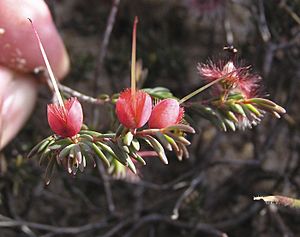Small featherflower facts for kids
Quick facts for kids Small featherflower |
|
|---|---|
 |
|
| Verticordia humilis near Kukerin | |
| Scientific classification | |
| Genus: |
Verticordia
|
| Species: |
humilis
|
The small featherflower (scientific name: Verticordia humilis) is a pretty flowering plant. It belongs to the myrtle family, called Myrtaceae. This special plant only grows in the southwest part of Western Australia. It's a small bush with lots of leaves. You can spot its mostly red flowers hanging loosely near the ends of its branches.
Contents
What Does the Small Featherflower Look Like?
The small featherflower is a shrub that usually grows about 10 to 30 centimeters (4 to 12 inches) tall and wide. Sometimes, it can spread out to 60 centimeters (2 feet). It often has branches that spread out openly.
Its leaves are long and narrow, like a line. They can be 3 to 8 millimeters (0.1 to 0.3 inches) long and have a rounded tip.
Its Unique Flowers
The flowers grow in small groups that hang downwards. Each flower sits on a tiny stalk, about 1 to 2 millimeters (0.04 to 0.08 inches) long. When the flowers start to open, they are surrounded by small, pink or red leaf-like parts called bracteoles. These fall off quickly.
The base of the flower, called the floral cup, is shaped like a top. It's about 2.0 to 2.5 millimeters (0.08 to 0.10 inches) long. It has 10 clear ridges and is hairy near the bottom.
The sepals, which are like the outer leaves of the flower bud, are pink, red, or maroon. They are 3 to 4.5 millimeters (0.12 to 0.18 inches) long. Each sepal has 4 to 6 hairy sections. The petals are shaped like an egg and can be white, red, orange, or maroon. They are 2.0 to 2.5 millimeters (0.08 to 0.10 inches) long and are very hairy on the outside.
The style, which is part of the flower's reproductive system, is gently curved. It is 12 to 16 millimeters (0.47 to 0.63 inches) long. It has a few short hairs on one side, near its tip. Small featherflowers can bloom almost any time of year, but they mostly flower from August to November.
How Did It Get Its Name?
The small featherflower was first officially described in 1867. This was done by a person named George Bentham. He published its description in a book called Flora Australiensis Volume 3. The plants he studied were collected by John Septimus Roe.
The second part of its scientific name, humilis, comes from a Latin word. It means "lowly" or "small." This name was chosen because the plant itself is quite small.
Later, in 1991, another expert named Alex George looked closely at all the plants in the Verticordia group. He placed this specific species into its own special section called Recondita.
Where Does It Grow?
This featherflower usually grows in sandy soil. Often, this sand is found over gravel, loam, or clay. It likes to grow in areas with heath and shrubland, often alongside other types of verticordia plants.
You can find it in the region between Kukerin, Ongerup, and the Frank Hann National Park. Some groups of these plants also grow further east, near Esperance. These areas are part of the Esperance Plains, Jarrah Forest, and Mallee regions.
How Does It Get Pollinated?
Scientists think that the way the petals and sepals are arranged makes it hard for small insects, like ants, to reach the sweet nectar inside the flowers. Nectar is a sugary liquid that attracts pollinators.
Because of this, it's likely that the small featherflower is pollinated by birds or even small mammals. These animals might be better able to reach the nectar and help the plant spread its pollen.
Is It Endangered?
The Western Australian Government's Department of Parks and Wildlife has looked at the small featherflower. They have officially said that it is "not threatened." This means it is not currently at risk of disappearing.
Can You Grow It at Home?
People have tried to grow the small featherflower from cuttings. Cuttings are small pieces of a plant that can grow into a new plant. However, it has been quite difficult to get these cuttings to grow well and become established plants in a garden.

